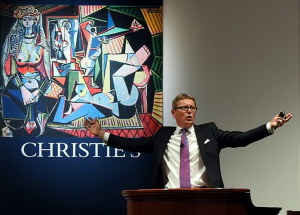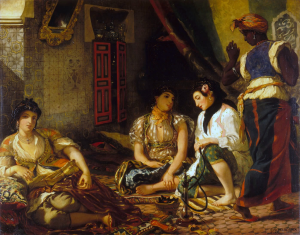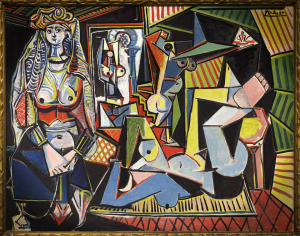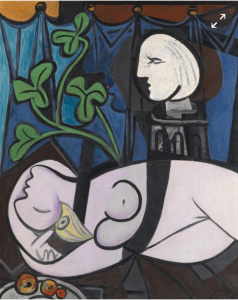Money cascades into the Art Market
May 18th, 2015 | By Ivan Lindsay | Category: JournalChristie’s, Sotheby’s and Phillips modernist works sales last week topped US$2.5bn with more fast money chasing art than at any time since 2008. Picasso’s Women of Algiers made a new auction record for a work of art of US$179m. Giacometti’s life-size sculpture L’homme au doigt sold for US$141.3m confirming that sculpture has now achieved the same status and value as painting. In 2014, according to the Financial Times, the art market turned over US$66bn, topping the last peak achieved in 2007 by 74%.
Jussi Pylkkanen, who auctioned the Picasso for Christie’s in New York, looked like he was having some kind of religious experience. With arms outstretched, before dramatically bringing down the hammer, it wasn’t clear if he was preparing for take-off or doing an impersonation of Anthony Gormley’s Angel of the North.
The painting was a second-rate Picasso carried along by the masterful hype drummed up by the slick PR department of Christie’s New York. By 1954 when Picasso made 15 oils very loosely based on Delacroix’s Women of Algiers in their apartment of 1834, he had lost his mojo and was down to painting pastiches of his former works. His passion, anger and energy faded as he entered his mid 70’s and this is clear in his work. As Kenneth Clark said, “Almost all great painters in old age arrive at the same kind of broad, simplified style, as if they wanted to summarize the whole of their experience in a few strokes and blobs of colour.”
Delacroix’s original shows three women sitting in an apartment with a standing maidservant just leaving the room. Because the women in Algeria would not let Delacroix paint them for religious reasons, the only place he could find some women to paint was in a harem. The women are languid and look pale and bored.
Picasso version is a mass of crude simplifications of body parts chopped up and re-arranged in a childish fashion.
One wonders who is advising the buyer of this picture, or if they take any advice, or even… if there is anyone remaining out there who knows anything about art. Some of this new money pouring into the art market is in such a hurry, and so clueless, they are cannon fodder for anything that comes up by one of the big names. Now Picasso has his moments but they were mainly during 1910 – 1940. If you are going to spend this sort of money, or anything close to it, you need to ensure you buy something that has some of his magic dust scattered on it….think Blue period, Rose period, cubist works, even (just) the large pictures of the 1940’s like the Nude Green Leaves and Bust which sold in 2010 for pounds 66m.
Picasso still acts like catnip for new buyers of art as I have elaborated on elsewhere: See http://www.spearswms.com/news/why-picasso-is-attractive-for-first-time-art-buyersand-auctioneers/#.VVdU1tNViko According to John Richardson Picasso’s appeal lies in the paradox of his character: “Extreme kindness, extreme cruelty: extreme generosity, extreme stinginess.”
Women of Algiers last came up 18 years ago when the collectors Victor and Sally Ganz sold it through an auction house to a London dealer for US$31m. Baron Robertson of EliteTrader.com did the maths and calculated it is a compound interest of 9%, a good return but not a ridiculous one.
However prices are frothy at the moment with huge prices achieved for works by Rothko, Liechtenstein and Pollock. And its not just paintings and sculpture; a jewellery sale in Geneva last week at Sotheby’s made US$ 161.5m. TEFAF estimates that the rich spend more on jewellery, watches and gems than they do on art.
The current art market has a slightly ethereal feel to it, a sort of post-fin-de-siècle giddiness that last appeared in the Japanese rush for Impressionists in the late 1980’s.
Great art comes out a struggle to represent an image or a feeling. There is something unsettling when the casual ease with which objects are bought in this current market is contrasted with the struggle that went into making them. As Mark Rothko said, “When I was a younger man, art was a lonely thing: no galleries, no collectors, no critics, no money. Yet it was a golden time, for then we had nothing to lose and a vision to gain.”
By most indicators including: – retail sales, wholesale sales, factory new orders, wholesale inventories, export growth and import prices, the US economy is approaching recession, after 5 years of expansion since 2009. However, the economic cycle is no longer possible to call because of the Fed’s Quantitative Easing program that started in 2009 and ran until October 2014. Should the US slide into recession then the Fed is quite capable of cranking up the QE program once again and the flood of liquidity will propel the art market to new heights.
For short term investors, at some point, probably in the not so distant future there is going to have to be a cooling-off period, because there always is, and as the Chinese say, “No tree grows into the heavens.” In the meantime, it is probably time to take profits and make hay while the sun shines.
The best way to buy art is as a long-term investment. Buy the best and hold on to it. Then you do not have to worry about economic cycles and timing the market. However, you need to know what to buy, and it seems, in this frantic market, that most people have no idea what they are doing and are going to get badly burnt when the market turns.




